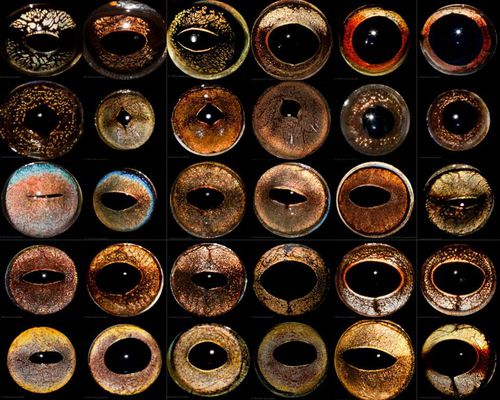Portal:Science
Science
Science, as a body of knowledge as we know it today, is remarkably young, not more than a few hundred years old. And what we know also as science largely relates to the facts and explanations of everyday life. There is a need to examine what constitutes science as a process, the discipline of doing science. What are those elements of study and practice that distinguish science as an endeavour? What are the social dynamics that influence the practice of science? What are the limits of science itself? These are questions that have to be considered by a student of science. Science is also often understood as learning science as a subject and this involves the teaching and learning science and the pedagogy that must be adopted to develop a scientific bent of mind and to prepare the learner for doing science. This is a portal for students and teachers to understand and share resources on both these areas.
Interesting news
Did you know?
Frog Eyes!!

IDs L-R by row number:
1: Pedostibes tuberculosus, Ghatophryne ornata, Duttaphrynus melanostictus, Hylarana sp., Hylarana sp., Clinotarsus curtipes
For more information click here
- Each of these images is cropped from a macro image of a live frog photographed in the wild.
- None of them were harmed.
Tiktaalik roseae - Between fish and land animal
Tiktaalik is a new species that was disovered in 2006 that has fish like features and features like a land animal. They have features of fish as well as tretrapods. Several fossils have been discovered of this fish. An extant fish Alligator Gar resembles the Tiktaalik most. Click here for more details.
Why the platypus will never have a stomach
Researchers have found that the animals without stomachs have completely lost the complex genes required for gastric digestion. Click here to read more.
Hexagonal North Pole of Saturn
There is a hexagonal cloud over the North Pole of Saturn. This was first discovered in 1980s and astronomers are trying to understand why this is happening. Click here to read more.
More news
HOW OUR BRAIN WORKS AND HOW SMART IS YOUR RIGHT FOOT
Famous Scientists
A question in a Physics exam at the University of Copenhagen, Denmark several decades ago said: "Describe how to determine the height of a skyscraper with a barometer." One student replied: "You tie a long piece of string to the neck of the barometer, then lower the barometer from the roof of the skyscraper to the ground. The length of the string plus the length of the barometer will equal the height of the building."
This highly original answer so incensed the examiner that the student was failed. The student appealed on the grounds that his answer was indisputably correct, and the university appointed an independent arbitrator to decide the case.
The arbitrator judged that the answer was indeed correct, but did not display any noticeable knowledge of physics. To resolve the problem it was decided to call the student in and allow him six minutes in which to show a minimal familiarity with the basic principles of Physics.
For five minutes the student sat in silence, forehead creased in thought. The arbiter reminded him that time was running out, to which the student replied that he had several extremely relevant answers, but couldn't make up his mind which to use. On being advised to hurry up the student replied as follows: "Firstly, you could take the barometer up to the roof of the skyscraper, drop it over the edge, and measure the time it takes to reach the ground. The height of the building can then be worked out from the formula H = 0.5g x t squared. But bad luck on the barometer."
"Or if the sun is shining you could measure the height of the barometer, then set it on end and measure the length of its shadow. Then you measure the length of the skyscraper's shadow, and thereafter it is a simple matter of proportional arithmetic to work out the height of the skyscraper."
"But if you wanted to be highly scientific about it, you could tie a short piece of string to the barometer and swing it like a pendulum, first at ground level and then on the roof of the skyscraper. The height is worked out by the difference in the gravitational restoring force T = 2 pi square root (l / g)."
"Or if the skyscraper has an outside emergency staircase, it would be easier to walk up it and mark off the height of the skyscraper in barometer lengths, then add them up."
"If you merely wanted to be boring and orthodox about it, of course, you could use the barometer to measure the air pressure on the roof of the skyscraper and on the ground, and convert the difference in millibars into feet give the height of the building."
"But since we are constantly being exhorted to exercise independence of mind and apply scientific methods, undoubtedly the best way would be to knock on the janitor's door and say to him 'If you would like a nice new barometer, I will give you this one if you tell me the height of this skyscraper'."
The student was Niels Bohr, who went on to win the Nobel Prize for Physics.
For more stories about scientists click here
